SOME big changes to the mechanisms that underpin traditional relationships between beef producers and processors may be in the wind, if a ‘big picture’ presentation delivered at the ABARES Outlook conference in Canberra yesterday was any indication.
Teys Australia’s general manager for corporate services, Tom Maguire, used the occasion to outline the company’s vision for a transition to a true value-based marketing system for the beef industry, which is based around a ‘consumer first’ approach.
With its processing footprint stretching from South Australia, through Victoria, NSW and into Central Queensland, Teys was committed to the long-term viability of the industry, Mr Maguire told the audience.
“The success of our company is intrinsically linked to the success of the broader beef industry – and that includes all sectors,” he said.
He presented the slide below to provide some context during his presentation, illustrating the traditional commodity cycles that occur across the supply chain.
The problem with that was that it produces ‘winners and losers’, with the cycles applying equally to producers and processors.
“The processing sector was on the top of that curve for the past two years, but it is probably now nearing the bottom, and that’s unlikely to change next year, based on industry forecasts,” he said.
“At the same time, the producers’ fortunes are often the inverse of what they are for processors.”
Mr Maguire said a true definition of sustainability was one where everybody could be profitable at the same time.
“As an industry, we have to get away from that volatility, and at present, we have no control over it. It’s driven by outside forces – the weather, the dollar – it’s a crazy way to run any business when you cannot put your hands on the steering wheel.”
What was exacerbating that impact in Australia was our beef industry’s inability to compete on the world stage on price. Labour represented about 65 percent of an Australian processor’s cost to do business.
He illustrated our lack of competitiveness using this graph outlining hourly labour costs in food manufacturing in Australia, compared with other large beef exporting countries including NZ, the US, Brazil and Mexico.
Cattle prices also contributed to Australia’s competitiveness position. Using January data provide by MLA, he said live cattle prices in Australia in USc/kg terms were US214.62c/kg, compared with Brazil at US123.34c/kg.
“Those numbers were almost the opposite this time last year,” he said. “All that says that given our costs and the nature of the commodity cycle, we are not going to generate sustainability for the broader industry unless we do something completely different,” Mr Maguire said.
The opportunities through VBM
“In our opinion, that’s about re-engineering things, and putting the consumer at the front. After all, that is where all the money that filters through the industry ultimately comes from.”
“We know from some of MLA’s ‘Willingness to pay’ consumer research that consumers – in all customer countries – are prepared to pay more for beef, provided they get quality and consistency. But what’s really important is that it’s not so much about the attributes of the product, but what the consumer is really prepared to offer reward for is consistency.”
He said in today’s market, beef could be regarded as a luxury item, not a commodity. “But consumers will pay well for beef, provide we give them what they want, whether that be ‘good every day’, special occasion’, or ‘very special occasion’.”
Mr Maguire reminded the ABARES audience that beef processing was really a ‘de-construction’ or ‘reverse manufacturing’ business, pulling a carcase apart into its component parts and finding the best possible home for each.
The second challenge was that processing involved ‘liquorice allsorts’, producing raw material from everything from premium cattle to cull cows.
“Currently, stakeholders all measure value differently, whether that uses a livestock language, a meat language, or a consumer language. But this results in value signals being heavily distorted, up and down the chain.”
“But while the solution is simple, in theory, it is more difficult to deliver in practice. It really should be just a simple yield-times-quality equation (example below), feeding into a tiered branding structure, on which payment is made.”
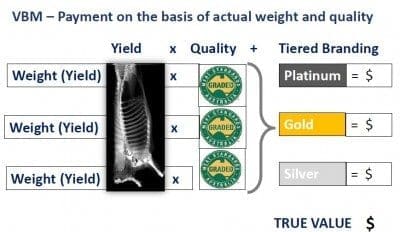 “But as we all know, it is far more complex than that. In order to make progress towards a better system, it’s going to need all sectors of the industry moving forward, together, in areas like the Australian beef Language White Paper.”
“But as we all know, it is far more complex than that. In order to make progress towards a better system, it’s going to need all sectors of the industry moving forward, together, in areas like the Australian beef Language White Paper.”
“Sensible agreement around the White Paper would do more to put money in producers’ pockets than almost anything else the industry can think of,” Mr Maguire said.
Relationships based on trust
In order to move forward, the industry needed a foundation of stronger supply chain relationships, built on trust.
“We need to move from confused and complicated trading descriptions to direct value indicators; from averaging to accurate individual value of each carcase; and from a ‘win/lose’ to a ‘win/win’ situation through improved product,” he said. “It’s about shifting from a commodity trading culture to collaboration.”
Critical to that was changes to the current grading and pricing system, based on grids which can distort proper supply chain signals.
Value-based payment would help unlock the potential in any cattle herd, Mr Maguire said.
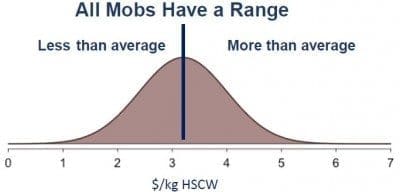 “A producer selling a processor a mob of cattle typically thinks they are all the same. But in truth, every mob has a range in performance.”
“A producer selling a processor a mob of cattle typically thinks they are all the same. But in truth, every mob has a range in performance.”
He used the above graph to illustrate the differences in value on a given mob of cattle, paid on a typical Teys grid versus the same cattle rewarded via value-based marketing.
What it clearly shows is that the current grid system fails to identify the significant value differences between individual animals, based on yield and quality. The differences reflected in grid value across animals are negligible, compared with those exposed via VBM (see graph below).
“And it gets worse when that comparison is applied across mobs,” Mr Maguire said.
The graph below, plotting the value-based marketing (yield+quality) price of six different mobs, against the grid average, shows huge differences. Even the average of each mob (horizontal line marked in colour) is widely different from mob to mob – with differences worth up to $600 or $700 between individual cattle in each group.
“What’s incumbent on us, as processors, is to send the right information back to producers to drive changes, and drive value,” he said.
The way to do that was to build a system that objectively describes quality, as seen by the consumer.
“Our current grading system is built around traits like boning groups, dentition and sex – but really it has to be about brand value, based on the consumer eating experience.”
Technologies big driver
Mr Maguire illustrated some of the big advances now occurring in objective carcase and live animal assessment for both yield and quality, driven by technology. Colour sensing, carcase yield and other important traits could now all be measured using new advances in technology.
“Objective carcase measurement will enable greater grading accuracy and industry confidence in measurements,” he said. “Currently we use traits like butt shape, P8 and rib fat, sex, eye muscle area and carcase weight to explain only about 40pc of carcase yield accuracy. New technologies now coming on the market will explain 100 percent.”
Mr Maguire said there was currently a funding proposal before the Federal Government to support MLA and AMPC to fully-develop assessment systems using the suite of new technologies. The proposal was put forward via the Rural Research for Profit grant program.
“If the government wants to have just one really big impact on the red meat industry, this is it” he said.
The key to extracting benefit from all of this was accurate and relevant feedback linking consumer value back to the producer.
That producer information needed to cover four key points, Mr Maguire said:
- What is the true value of each animal?
- What is creating the value difference?
- How can I identify the good and the bad?
- How can I instigate continuous improvement?
“Clear price signals like this will drive dramatic change, in our opinion,” Mr Maguire said.
“The dairy industry is a great example. Annual milk production in 1980 averaged 2848 litres per cow. By 2012, that had risen to 5891 litres. Why? Milk producers reacted to clear price signals. The same genetic and management tools work in the beef industry, as in dairy. The message is, provide the right price signals, and the producer will do the rest. Look at what dairy has achieved.”
If all this occurred, traditional carcase-based description could then be consigned to history, he said.
“What do traits like dentition and weight have to do with eating quality?”
A successful conclusion on the language white paper can help shift from a traditional, highly complex meatworks grid like that pictured below, to a greatly simplified pricing structure might like that pictured on the right.
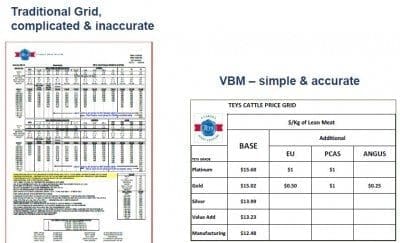 “Ultimately (as illustrated in the graph, below left) it is about shifting the whole national herd in the right direction, and reducing the number of outliers,” Mr Maguire said.
“Ultimately (as illustrated in the graph, below left) it is about shifting the whole national herd in the right direction, and reducing the number of outliers,” Mr Maguire said.
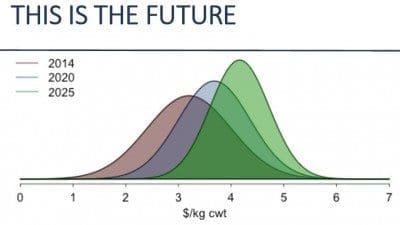 “Knowledge is power, and accurate feedback relays value signals to the producer – and importantly, stimulates action. A higher-value animal costs the same to breed, feed and process, but the additional value can be shared among the supply chain participants,” he said.
“Knowledge is power, and accurate feedback relays value signals to the producer – and importantly, stimulates action. A higher-value animal costs the same to breed, feed and process, but the additional value can be shared among the supply chain participants,” he said.
“Teys is committed to this path, because it’s what the consumer wants.”
- Teys first floated the concept of its planned move to Value-Based Marketing in this Beef Central article, following a supplier gathering in Queensland last year.

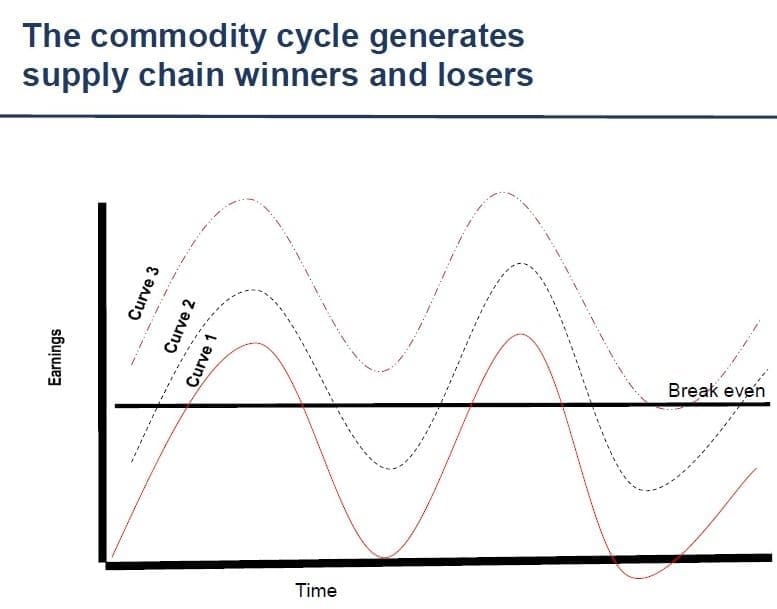
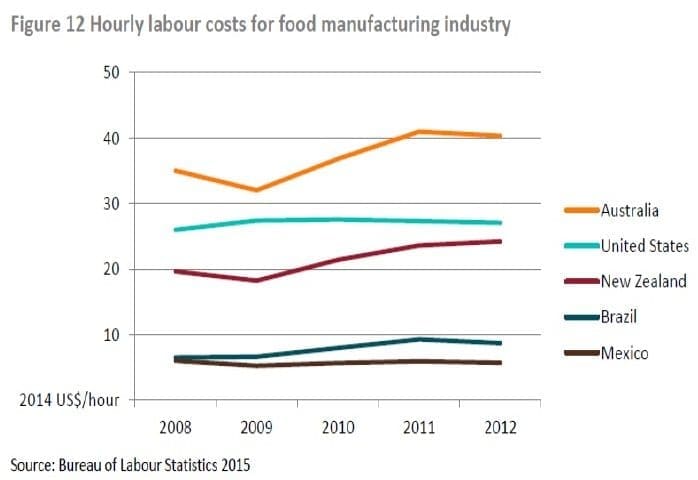
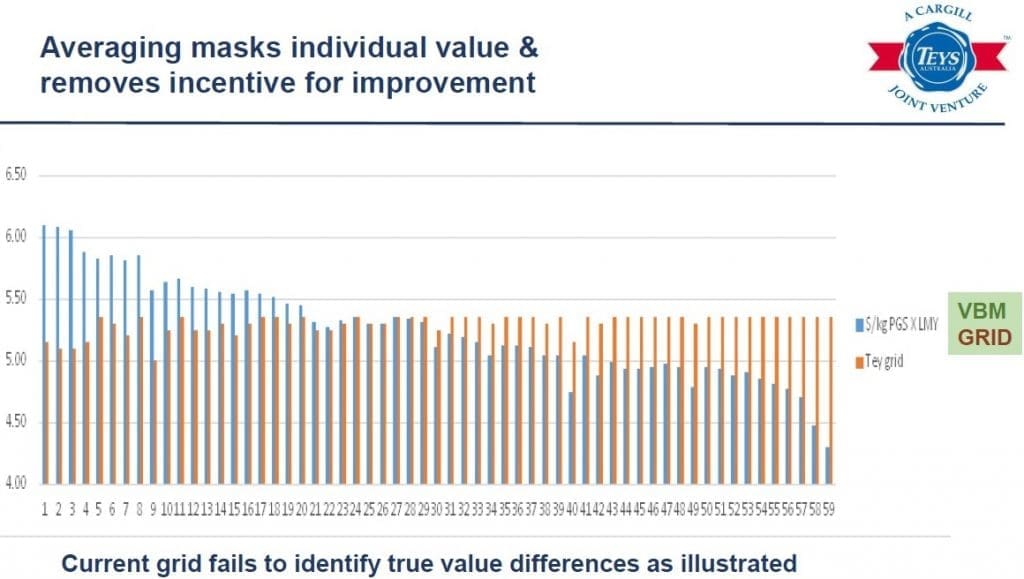
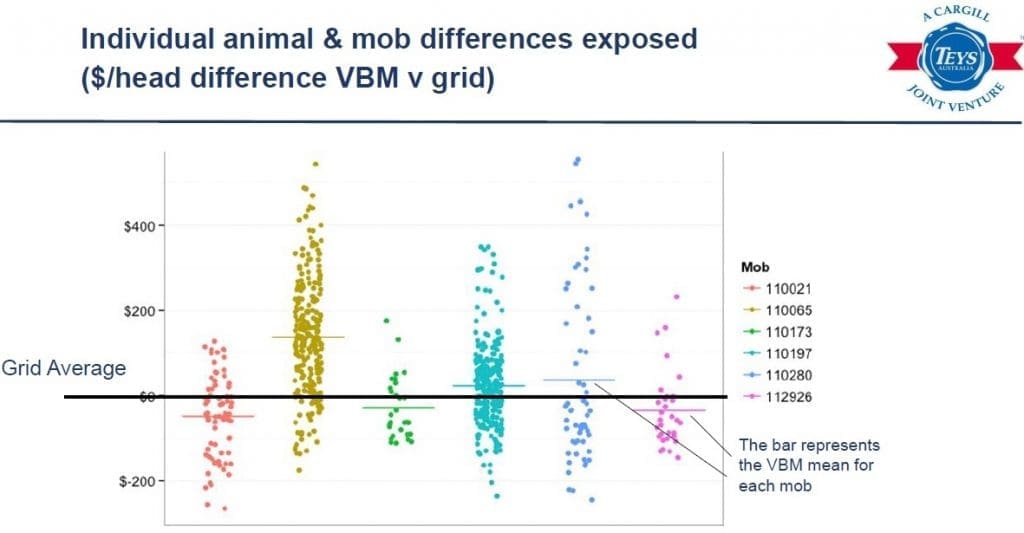


I read with interest where Mr Maguire from Teys made some fascinating statements at the recent ABARE conference.
In order to move forward the industry needs a foundation of stronger supply chain relationships built on trust.
We need to move from a confused and complicated trade descriptions to direct value indicators.
Critical to change was the current grading system and pricing system, based on grids which can distort supply chain signals (how true).
A chart shows the cost of wages in Australia which are far more expensive than our competitors. There is no mention of the fact that in other countries producers get a share of by products and a dressing percentage can be much higher than Australia producers could expect. These two factors alone could have significant bearing on processor margins. Could it be possible that the wage factor may be mitigated by more favourable trading conditions?
Mr Maguire says a true definition of sustainability is where everybody could be profitable at the same time, and as an industry we have to get away the volatility. And at present we have no control over the steering wheel and how can anybody control of business under these circumstances..
To my way of thinking what we have now is a petrol motor tried to run on diesel fuel, is simply doesn’t work.
Surelly change is not an option, it is a complete necessity and the sooner we realise that the better the whole industry will be.
This is what producers have been wanting for years, if VBM is to be successful it must have integrity. All value chain participants have to recognise we are not a low cost of production country, this is not unique to our industry. While achieving a return based on true value is something that will be necessary if we are to have a viable industry, quoting labour costs in countries such as Brazil and Mexico are not that helpful in my opinion, do the Mexican workers in the US receive the rate of pay quoted? There are two things that concern me about the price differential between the price in Brazil compared to Australia this year and last year, how accurate is the MLA price reporting, are we talking about the same product and what was the boxed beef price differential? Identifying what animal is likely to be the most profitable to the value chain is only half the equation, extracting the maximum price for the boxed beef product in the global beef trading market and all participants receiving a return based on that price will ultimately determine the success of the new business model. This will mean significant changes to trade description and importing country protocols for the product that is exported. There are challenges ahead, but there has been no better time for industry to work together to achieve outcomes that will set the future sustainability framework for the beef industry value chain. While we may not be able produce commodity beef as cheaply as other countries, we have a product that is the equal to any in the world as far as the things that matter to the consumer go. We have MSA which allows the eating quality to be measured in a way that is second to none, once we have an acceptable method to determine yield, we must then shift our trade description and price determination methods accordingly. Congratulations Teys, the opportunities mentioned and the shifting business model is the way of the future.
VBM – code for more confusion and less transpatrency. Like Golden Rewards with AWB wheat grades. What happens in these systems is that the ”fair average quality’ price soon becomes the ‘top’ price available on the grid, and there are ever-more reasons found to discount prices to the grower. Yield management has been used in the airline industry for years, and is spreading into all businesses. What it is, is simply gouging at both ends of your business – discounts to the grower and asking top-dollar of the consumer, ‘what the market will bear’ approach. As the ABA repeatedly say, is that we need transparency and independence of grading, not company VBM. Substitution of product is also a growing concern. Whether it is hogget for lamb, or export rump/A cipher and not prime yearling beef, it destroys consumer trust in the product, and this is exactly what has happened, and consumption drops. When a producer sells an animal it is plain for all to see what it is – age, mouth, condition, weight. The buyer has no doubt about what it is when he bids on it. Not so the consumer.
Full names required for comment on Beef Central please Grant, as per our long-standing comments policy. Click here to view.
this article is well worth reading – it gives some good insights into how TEYS are developing their business model and interactions with producers